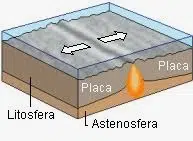Before entering fully into the meaning of the term lithosphere, we are going to proceed to discover its etymological origin. In this case, we can emphasize that it is a word that derives from Greek. Specifically, it is the result of the sum of two lexical components of said language:
-The noun «lithos», which is synonymous with «stone».
-The word "sphaira", which can be translated as "sphere" or "globe".
The lithosphere is the rocky layer that surrounds the Earth's globe. This is the surface that makes up the outer crust of planet Earth .
 The term can also be accented on the letter E : lithosphere . The use of one or another form depends on the region, although both are valid as indicated by the Royal Spanish Academy ( RAE ) in its dictionary .
The term can also be accented on the letter E : lithosphere . The use of one or another form depends on the region, although both are valid as indicated by the Royal Spanish Academy ( RAE ) in its dictionary .
The thickness of the lithosphere varies between 50 and 100 kilometers , according to most meanings. Its lower limit is generally considered to be the asthenosphere (the upper zone of the mantle), while its outer limit is the Earth 's surface .
In the lithosphere, fragments called lithospheric plates or tectonic plates can be distinguished. These plates move on the asthenosphere: when a large movement is recorded, an earthquake occurs.
Among the largest tectonic plates we find the Eurasian, North American, Antarctic, African, Pacific, South American and Indo-Australian plates. On the contrary, among the smallest are those of the Caribbean, Cocos, Philippine, Arabian, Nazca, Juan de Fuca and Scotia.
The movement of lithospheric plates is explained by plate tectonics , a theory focused on the dynamics and structure of our planet. It is important to highlight that orogenesis, seismicity and volcanism are concentrated at the edges of the plates that make up the lithosphere.
Among the most significant types of contacts between the aforementioned plates are the collision of an oceanic lithosphere with a continental one, the so-called plate separation or the collision of two continental lithospheres, for example. This last type of contact is the one that occurs in the Himalayas.
Of all the Earth 's layers, the lithosphere is the stiffest and coldest . While the upper sector generally presents a temperature similar to that recorded in the environment , at a depth of one hundred meters the temperature increases by about 35 ºC .
It is possible to differentiate between the continental lithosphere (linked to the continental crust ) and the oceanic lithosphere (which is associated with the oceanic crust). The continental lithosphere is thicker than the oceanic lithosphere.
From the continental lithosphere we can establish that it has an average thickness of 120 kilometers and that it is made up of both the residual mantle and the continental crust.
On the other hand, it is also worth knowing that the average thickness of the oceanic lithosphere is between 7 kilometers, in the area of the oceanic ridges, and 65 kilometers in the rest of its structure. It is made up of the oceanic crust and the relevant residual mantle.
